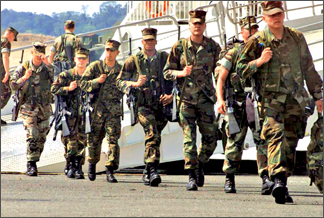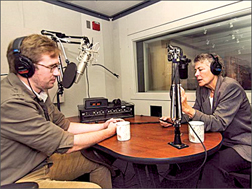|
Opinion
Brutal massacre of white flag-bearing Taliban
surrendees under US watch:
No criminal probe yet
The Boston-Massachusetts-based Physicians for Human Rights (PHR) has
renewed its call for a criminal probe in the wake of a major New York
Times story with new evidence that the Bush Administration impeded at
least three federal investigations into alleged war crimes in
Afghanistan in 2002.
PHR is calling for Obama administration's Department of Justice to
investigate why the Bush administration impeded an FBI criminal probe of
the alleged Dasht-e-Leili massacre.
According to US government documents obtained by the PHR, as many as
2,000 surrendered Taliban fighters were reportedly suffocated in
container trucks by Afghan forces operating jointly with the US in
November 2001. The bodies were reportedly buried in mass graves in the
Dasht-e-Leili desert near Sheberghan, Afghanistan.
 |
 |
|
Nathaniel Raymond (L) has been leading
the investigation into the alleged 2001 Dasht-e-Leili
massacre in Afghanistan. Dr. Jennifer Leaning (R) discovered
the mass grave of Taliban prisoners. Both work with the
organization Physicians for Human Rights. |
The Taliban fighters surrendered with white flags and open arms to an
assurance that they will not be harmed. The surrender took place under
the watch of the NATO/US command, and the subsequent mass massacre
happened with total knowledge of the US Command in Afghanistan.The
burial of the two thousand Taliban fighters in mass graves could not
have taken place without the knowledge of the US Command in Afghanistan.
Notorious Afghan warlord General Abdul Rashid Dostum, who was
reportedly on the CIA payroll, is allegedly responsible for the
massacre.
Dostum was restored to his Afghan defense ministry position by
President Karzai just before the recent presidential election.June11,
2009 The New York Times carried a front page story about the massacre,
and soon after President Obama in an interview with the CNN said that he
has asked his National Security Council to gather information and review
for him. He did not specifically say at the CNN interview that he will
initiate a full-scale investigation.The 2009 is coming to a close but we
have not heard from the Obama administration of the 'progress' of his
national security council team's review.
Asian Tribune today carries the full transcript of a video interview
given by the officials of the Boston-based Physicians for Human Rights
which gives details of the massacre of the surrendered Taliban fighters.
The video, detailing nearly eight years of advocacy and investigation
by Physicians for Human Rights, explores the events surrounding the
massacre and subsequent cover-up.
Those who participated in the interview were Physicians for Human
Rights' CEO Frank Donaghue, Campaign Against Torture Director Nathaniel
Raymond, and Deputy Director Susannah Sirkin. This was narrated by Jared
Voss.PHR was founded in 1986 on the idea that health professionals, with
their specialized skills, ethical duties, and credible voices, are
uniquely positioned to investigate the health consequences of human
rights violations and work to stop them. The PHR is headquartered in
Cambridge, Massachusetts, and maintains an office in Washington, DC.
It is a non-profit, non-sectarian organization funded through private
foundations and by individual donors. Membership is open to all, not
just health professionals. PHR shared the 1997 Nobel Peace Prize.
War Crimes and the White House
The Bush Administration's Cover-Up of the Dasht-e-Leili Massacre
(Transcript of Video).
Frank Donaghue (CEO, Physicians for Human Rights): A new
administration is in the White House. And the prison at Guantanamo Bay
will soon be closed.
But the investigation into war crimes must not close with it.
Guantanamo is neither the end nor the beginning of the story. The Bush
Administration's blatant disregard for the rule of law goes back before
Gitmo, before Abu Ghraib, and before the CIA "Black Sites". It goes back
to Dasht-e-Leili.
Narrator (Jared Voss): In November 2001, as many as 2,000 prisoners
are believed to have been murdered by US Allied Afghan troops and buried
in a mass grave in Dasht-e-Leili, Afghanistan. These Afghan troops were
operating jointly with American forces.
The New York Times has revealed that the Bush administration blocked
at least three separate investigations into these alleged war crimes.
This revelation comes after nearly eight years of advocacy and
investigation by Physicians for Human Rights.
Citing a former FBI agent and other sources, the Times reports that,
beginning in 2002, senior Bush administration officials obstructed a
series of criminal probes by the FBI, Defense Department, and State
Department.
This story begins in Northern Afghanistan, November 2001, when
thousands of Taliban and foreign fighters surrendered to US Special
Forces and the troops of Afghan warlord General Abdul Rashid Dostum, a
notoriously brutal US ally in the Northern Alliance. The prisoners were
promised they would not be harmed.
Nathaniel Raymond (PHR's Lead Researcher, Dasht-e-Leili
Investigation): Instead, Dostum packed them in shipping containers where
they were carried in a convoy through the desert. According to US
government documents obtained by PHR, up to 2,000 people died during
that convoy. They were buried at a place called Dasht-e-Leili, which is
a mass grave site near Sheberghan, Afghanistan.
Susannah Sirkin (PHR Deputy Director): PHR discovered the grave while
we were investigating the conditions at the Sheberghan prison in
northern Afghanistan. Our team found conditions at that prison to be
absolutely deplorable. There were 3,000 prisoners in an over-crowded
place that lacked heat, adequate nutrition. Prisoners were dying of
illness, and lack of sanitation, and hunger.
At the time, our investigators also heard stories about a mass grave
right near the prison. And they saw some of the outlines of such a site.
So under the auspices of the UN, our International Forensic Program
conducted an initial examination of part of the grave, exhumed some
bodies, and conducted autopsies and found those deaths were consistent
with suffocation.
Narrator: First privately and then publicly, PHR appealed to US and
Afghan authorities to fully investigate this alleged massacre. They
called for evidence to be preserved and witnesses protected. Despite
these appeals, Afghan eyewitnesses were tortured, murdered, or simply
disappeared.
Nathaniel Raymond: The Pentagon had said that only a few dozen
prisoners had died during transport, of their wounds or of disease. The
Pentagon also said that they had verbally debriefed the Special Forces
when they returned from Afghanistan, and didn't need to do further
investigation.
Narrator: Not only was the incident not investigated, but that year,
General Dostum was brought into the Afghan government as Deputy Defense
Minister under President Hamid Karzai. And it has now been revealed that
General Dostum was actually on the payroll of the CIA.
Two of Dostum's supporters were Secretary of Defense Donald Rumsfeld
and Deputy Secretary Paul Wolfowitz. According to the New York Times,
officials told Wolfowitz that Dostum may have committed a war crime.
Wolfowitz said they would not go after him for that.
Susannah Sirkin: It was the policy of the US and Afghan governments
to bring in the Afghan warlords who were, many of whom were alleged war
criminals and were the cause of the mass graves across Afghanistan - to
bring them into the government.
Narrator: A few survivors of the Dasht-e-Leili massacre were
transported to Guantanamo Bay, where Dell Spry served as Special Agent
in Charge of FBI Interrogations.
Nathaniel Raymond: According to the New York Times, Special Agent
Spry and his team of FBI agents at Guantanamo interviewed 10 detainees.
Special Agent Spry submitted this information to FBI headquarters in
Washington. But he was ordered not to investigate.
Narrator: In August 2002, Newsweek magazine, using information
provided by PHR, published an exclusive cover story detailing
allegations about the massacre.
The release of this story pressured the US and Afghan governments to
publicly voice support for a joint investigation.But when the State
Department attempted to launch this investigation, the Bush White House
shut them down.
Susannah Sirkin: So over the next few years, PHR waited for an
investigation to take place at the Dasht-e-Leili grave. We at the same
time worked with the Afghan Independent Human Rights Commission to train
Afghan justice, police, and forensics people in the techniques for
documenting graves. And we started exercises to map all the mass graves
in Afghanistan.Our biggest fear all along was that someone might tamper
with the Dasht-e-Leili grave and destroy the evidence up there. And at
the same time, we kept seeking information from the US government, from
the Afghan government, about the Dasht-e-Leili grave and what happened
up there.
Narrator: With the White House continually blocking their requests
for information and investigation, PHR had only one option left. In
2006, they filed a Freedom of Information Act request seeking all US
government documents related to Dasht-e-Leili.
But the Bush Administration refused their request. After being
stonewalled for more than a year, PHR took legal action to force the
Government to comply.
Nathaniel Raymond: We sued. We won. And finally, we received
documents that indicated the US government believed up to 2,000
prisoners died during the Dasht-e-Leili incident.
Narrator: Soon after they obtained those documents, a member of PHR's
International Forensic Program discovered that the Dasht-e-Leili grave
site had been compromised and evidence had been removed.
McClatchy Newspapers reported that, according to Afghan government
officials and local law enforcement, fearing retribution, General Dostum
allegedly had his men dig up the site and remove the remains.
Susannah Sirkin: And it looks as though today, much of the evidence
in that grave has literally been removed. How could this happen after
all of the information has come out about this site? After the Newsweek
report? After PHR's investigation? After the UN has asked for
protection? After the Afghan government and the US government have said
that it is a crime that should be investigated?
Nathaniel Raymond: Leading international law scholars who have
reviewed the Dasht-e-Leili case believe that this massacre represents a
gross violation of the Geneva Conventions and is a war crime. Under
international law, the cover-up of a war crime is itself a war crime.
Narrator: From Afghanistan to Guantanamo Bay, from the FBI to the
White House, the Bush Administration covered it up.
Frank Donaghue: Witnesses have been tortured and killed and evidence
has now been destroyed. US law enforcement was obstructed by the Bush
administration. But, PHR, working side-by-side with some of the nation's
top investigative accountability.
Without these reporters, and without Physicians for Human Rights,
this story never would have been told. And it's now up to Attorney
General [Eric] Holder to continue the work that PHR and others have
started. And it's now up to you to join PHR in demanding that justice be
served. Sign our petition calling on our elected leaders to conduct a
fair, full, non-partisan examination of the facts.
Narrator: To learn more and take action, visit AfghanMassGrave.org.
Frank Donaghue: And help make accountability a reality.
The revelation of the 'white flag-bearing' Taliban fighters who were
given the assurance that their lives will be spared but were brutally
killed and buried in a mass grave is not hearsay but investigated hard
facts.
This story was not told by some newspaper reporter to an Army General
who himself used it in public to defame the Bush administration. Even
the United Nations could use such credible information of the Afghan
massacre to encourage the US government to initiate an investigation.
The UN which reacts on unsubstantiated reports of human rights abuses
in Third World countries ordering investigations of incidents which have
emerged due to hearsay has so far failed to seriously ask the United
Stated Government to initiate a criminal probe into the Afghan massacre.
- Courtesy: Asian Tribune
|

